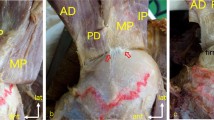Summary
Purpose of this study was the evaluation of distribution and morphology of mechanoreceptors in the glenohumeral joint capsule and rotator cuff in comparison to the coracoacromial ligament by means of specific immunfluorescence microscopy. The complemente joint capsules, rotator cuffs and coracoacromial ligaments of three fresh cadaver shoulder were harvested. Serial cryostate sections were taken and alternately incubated with antiserum against neurofilament, lamin or myelin of peripheral nerves. The antibody-reaction was visualized with fluorescin Ig-G. The nerve endings were photographed and computer-aided 3-dimensional reconstructions were performed. Three types of corpuscular and free nerve endings of different morphology were found in different distributions: whereas the Ruffini corpuscles were much more frequent in the coracoacromial ligament and rotator cuff, Pacini endings were predominantly found in the joint capsule. Generally corpuscular nerve endings were more frequent in the coracoacromial ligament and the rotator cuff than in the antero-inferior capsule and the number of corpuscles increased from medial to lateral within the anterior and inferior parts of the capsule. The dense ligamentous tissue was almost aneural whereas the periarticular fatty or loose connective tissue contained nerve fibres and nerve endings. In view of the results of other experimental and clinical studies the high frequency of Ruffini and Pacini endings in the rotator cuff and coracoacromial ligament suggest, that both are involved in the neurosensory control of glenohumeral stability and subacromial impingement. In contrast our findings in the joint capsule do not clearly proove, that those joint receptors predominantly maintain joint stability.
Zusammenfassung
Das Ziel dieser Studie bestand darin, die Verteilung und Morphologie von Mechanorezeptoren im Schultergelenk mittels spezifischer Immunfluoreszenz zu untersuchen. Die komplette Schultergelenkkapsel, Rotatorenmanschette und das Lig. coracoacromiale von 3 Leichen wurden innerhalb von 12 h nach Todeseintritt entnommen, Serienkryoschnitte angefertigt und diese entweder mit Neurofilament-, Laminin- oder Myelinantiserum und anschließend mit Fluoreszinantikörpern inkubiert. Die Nervenfaserendigungen wurden fotographiert und computerunterstützt dreidimensional (3D-) rekonstruiert.
Es wurden 4 verschiedene Rezeptortypen mit jeweils unterschiedlichen Verteilungsmustern nachgewiesen. Während Ruffini-Körperchen in der Rotatorenmanschette und im Lig. coracoacromiale am häufigsten waren, zeigten sich in der anterior-inferioren Gelenkkapsel vorwiegend Pacini-Körperchen. Während das dichte ligamentäre Gewebe kaum terminale Endigungen enthielt, fanden sich die meisten korpuskulären Rezeptoren in periligamentärem Fett- und lockerem Bindegewebe, bzw. in Spalten zwischen den Kollagenfaserbündeln. Unter Berücksichtigung bisheriger klinischer und experimenteller Studien ist die verhältnismäßig hohe Dichte korpuskulärer Nervenfaserendigungen in der Rotatorenmanschette und dem Lig. coracoacromiale als ein Hinweis auf eine Beteiligung dieser Strukturen an der neurosensorischen Kontrolle einer Dezentrierung im Glenohumeralgelenk und übermäßigen Druckerhöhung im subakromialen Raum zu werten. Die geringe Dichte korpuskulärer Endigungen und das Überwiegen von schnell adaptierenden Pacini-Körperchen in der antero-inferioren Gelenkkapsel spricht nicht dafür, daß diese Rezeptoren als sog. Spannungsdetektoren maßgeblich an der Stabilisierung des Glenohumeralgelenks beteiligt sind.
Similar content being viewed by others
Author information
Authors and Affiliations
Rights and permissions
About this article
Cite this article
Gohlke, F., Janßen, E., Leidel, J. et al. Histomorphological findings on proprioception in the shoulder. Orthopäde 27, 510–517 (1998). https://doi.org/10.1007/PL00003524
Published:
Issue Date:
DOI: https://doi.org/10.1007/PL00003524




